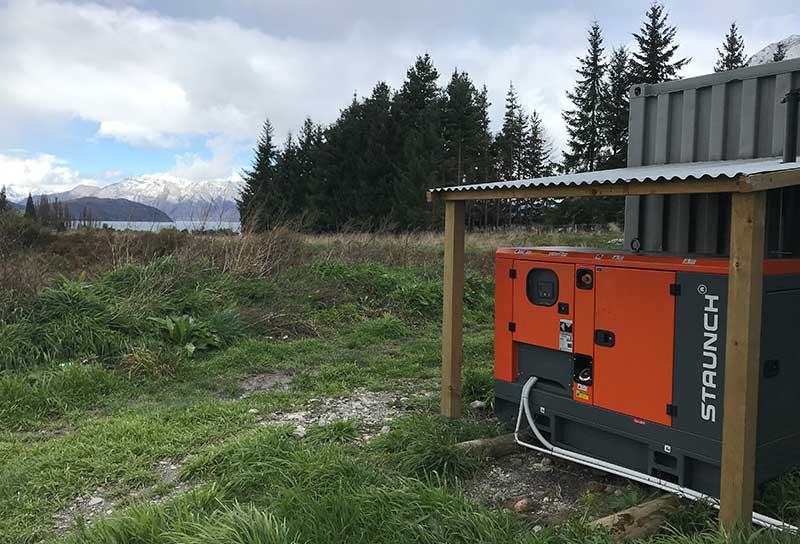
We regularly get asked questions about gensets for off-grid solar sites. This article will hopefully answer some of your questions, and help you make an informed purchasing decision.
The first point is the inverter charger is the heart of your system. This is your starting point, not the genset. If you ask ‘what size genset do I need’? Our first question will be what are the details of your inverter charger? Don’t scrimp on your inverter charger, this component more than any other affects your electrical quality of life off-grid.
Why do I need a genset for my off-grid power installation?
Insurance and flexibility
Your off-grid package has been sized by your solar provider based on the information you have given them about your power usage, load profile and the site environmental conditions. All of these points of reference are subject to change, but with a robust well-sized genset included as part of your system, the worst that should happen is the generator runs more often than predicted. By including a genset you have insurance against losing power after extended periods of inclement weather, insurance against excessive battery cycling which shortens the life of your expensive batteries and you have the flexibility to increase your load if required. Maybe you decide to buy a spa pool or it’s your turn to host 50 people for Christmas dinner. With the right genset as part of a well designed solar system, you should never have to make electricity sacrifices to live off the grid.
Ask your solar provider if they live off-grid, many do. Then ask if they, (with years of experience and access to the best inverter charger, battery and solar panel technology) have a genset. The answer will almost certainly be yes, and it will be a good one.
So now we have established why a genset is needed.
What type do you need?
Like with most things in life, with gensets you generally get what you pay for
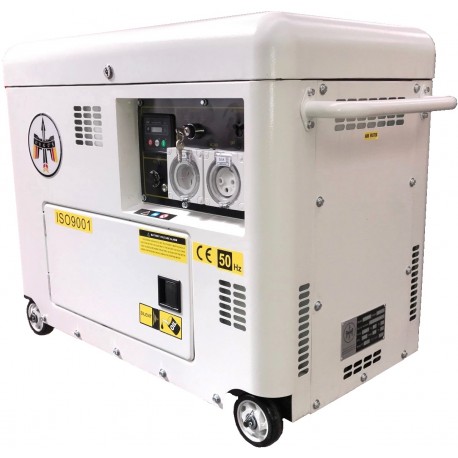
To try and simplify things (as much as possible) – for your purposes there are two basic types of genset. High speed ‘2-pole’ gensets that run at 3000rpm, and low speed ‘4-pole’ gensets that run at 1500rpm.
2-pole gensets are designed for light duty intermittent use. These cover practically all petrol powered gensets and a range of small air-cooled diesel sets. We offer our K-MAX 5 product in this range which is a popular, cost effective solution when sold into the right application. The definition of ‘light duty’ is the expected operating hours being less than 300 per year. This type of genset is ideal for a very robust off grid solar system, where only extended periods of inclement weather should make its services necessary. It should be thought of as a diesel powered battery charger only. It covers the insurance part of the first question above however offers little in the way of flexibility.
4-pole gensets are designed for prime power use. They are able to both charge your batteries and carry the house load simultaneously, so offer both insurance and flexibility for your system. 4-pole gensets are generally diesel powered, quieter and more durable than the higher speed 2-pole gensets, but the initial capital outlay will be higher. In many cases, this additional capex can be offset as with a prime power genset installed, a smaller battery bank and less solar panels are required because the genset will cover any short falls. Running this type of genset regularly is a good thing.
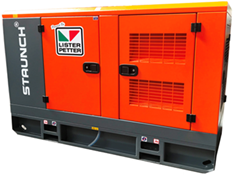
OK – but what size do I need?
Genset size is dictated by the draw of your inverter charger and your house load (the load profile). The load profile is made up of a base load, applied load and sporadic load. To size, start with the size of the inverter charger you are using and work forward from there. You definitely need to know this!
If using a 2-pole genset you simply need to know how much power your inverter charger draws to charge your batteries, as this is all it should be used for. This is the base load.
If using a 4-pole genset you have the flexibility to add the power the inverter charger needs for battery charging (base load) to the expected house load (applied load + sporadic load).
In a typical off-grid solar installation the base load is the charging load to the batteries, the applied load is the house load that the generator may take while charging the batteries and the sporadic load is things like water pumps that start and stop randomly. Keep in mind electric motors used in water pumps or sewage systems have an inrush current when starting which can be up to 6 times the running current of the motor. This needs to be allowed for. The most common cause of a seemingly random generator trip in an off grid site is a water pump starting in conjunction with another high load device such as an electric kettle or dishwasher.
It should be noted here that good quality modern inverters can be programmed to take a specified power draw for battery charging if a specific maximum load is required and some inverters will even optimise the loading between the battery charger and house load automatically. This can often mean a smaller genset can be used without fear of overload, but the trade-off is the genset will run longer to charge the batteries.
The genset guy keeps quoting kVA. Is this the same as kW (kilowatts)?
No. To avoid boring you with electrical blah blah blah, stick with kW (kilowatts) when talking about a genset for your solar system. The kVA is generally 20% more than its kilowatt equivalent so don’t get them confused or you will come in under powered.
How does the genset integrate into my solar system?
Your inverter charger controls the genset. It tells it to start to charge batteries or provide additional power as/when required. If the inverter you are looking at doesn’t have this facility, don’t buy it, find one that does. This is another example why you should start the buying process with the inverter
The inverter charger closes a circuit to start the genset. For this to work your genset needs to be fitted with a control panel featuring a 2-wire remote start facility. The inverter sends the signal, the genset starts and once up to speed and voltage, the inverter accepts power from the genset. We strongly recommend your system is designed to do this automatically and you leave it to work automatically. This will optimise your genset running time under the correct load and will also look after your system’s very expensive battery bank. The best inverter chargers will do many other clever things to both maximise the life of your system and ensure you never run short of electricity. Petrol gensets can struggle with remote starting as operating the engines choke requires an additional mechanical operation. There is an automatic choke option available but this is often problematic, particularly in colder climates. Petrol engines also produce poisonous carbon monoxide gas so must never be run in a confined space.
How does the genset integrate into my solar system?
Your inverter charger controls the genset. It tells it to start to charge batteries or provide additional power as/when required. If the inverter you are looking at doesn’t have this facility, don’t buy it, find one that does. This is another example why you should start the buying process with the inverter
The inverter charger closes a circuit to start the genset. For this to work your genset needs to be fitted with a control panel featuring a 2-wire remote start facility. The inverter sends the signal, the genset starts and once up to speed and voltage, the inverter accepts power from the genset. We strongly recommend your system is designed to do this automatically and you leave it to work automatically. This will optimise your genset running time under the correct load and will also look after your system’s very expensive battery bank. The best inverter chargers will do many other clever things to both maximise the life of your system and ensure you never run short of electricity. Petrol gensets can struggle with remote starting as operating the engines choke requires an additional mechanical operation. There is an automatic choke option available but this is often problematic, particularly in colder climates. Petrol engines also produce poisonous carbon monoxide gas so must never be run in a confined space.
If I’m using the genset in a standby application, should I use the gensets standby duty output rating?
No
A genset’s output generally has two published figures, Standby Power (ESP/LPP) and Prime Power (PRP), but there are also two other ratings to consider when sizing your genset.
Standby Power is defined as the maximum output of the genset – available 1 hour in 12. Do not think because your genset is to be used in a standby application you can use this rating. We don’t recommend using the standby power rating for anything other than short peak loads such as the inrush current when electric motor starting. While manufacturers data sheets claim this rating is available for 1hr in 12, in the real world engines will run out of horse power unless fully broken in, in perfect running order and operating in ISO 3046 environmental conditions (which isn’t possible inside a genset canopy).
The Prime Power rating is defined as the continuous duty rating under variable loads. Your genset can run up to this rating in its normal day-to-day operation. This is the rating to use when sizing your 4-pole off-grid genset as you have the base load from the battery charger plus the applied and sporadic house load.
The Maximum Continuous Power rating of a genset is the load it is designed to run at continuously (I know the clues in the name) The rule of thumb is its 70% of the prime power rating. This is the rating you should use for battery charging, for example a 5kW K-Max 5 should be spec’d to provide 3.5kW to the inverter charger.
The Minimum Continuous Power load is 40% of the prime power rating. This is equally as important to consider, as extended periods of light load running below a 40% load will cause severe long term damage to your genset’s engine.
So to summarise, a genset should be sized so that’s its typical load is 40 -70% of its prime power rating. That’s not to say loads outside of this range are intermittently unsustainable, rather this is the generators ideal operating zone.
What do I need to be aware of when installing my new genset?
Here is a list:
- Our canopied gensets can be installed outside, but like anything exposed to the elements they will weather faster. We recommend at least a roof over the set to keep the worst of the sun and rain off.
- Dust and dirt inside the genset’s alternator is your enemy. When moisture is added these will act as a grinding paste on the alternator windings eventually causing failure. Salt laden air is worse as you can imagine. Your genset alternator is air cooled, drawing air though it along with contaminants in the air, so the air provided needs to be as clean and dry as possible.
- Air flow is the key to a happy genset. You need cool, fresh, clean air for cooling and combustion and then need to get the warm used air away from the genset. The warm air cannot be allowed to recirculate. The exhaust outlet also needs to be designed in a way that exhaust fumes cannot recirculate through the genset.
- Do not install your genset in the battery room. This is dangerous and to our knowledge illegal. Equally ensure equipment and flammable materials are kept well clear of the genset.
- Care must be taken to ensure all exhaust gases are ventilated away from areas that are inhabited by people or animals. If extending the exhaust pipe, do so in a manner that does not increase back pressure on the engine. Please ask if unsure.
- The genset must be installed on a level surface, preferably on a concrete plinth. Put building paper or some other type of installation down between the genset and the concrete, as the concrete contains lime which will eventually eat into the metal.
- The genset will likely arrive with minimal fuel. It needs fuel to work so filling will be necessary.
- Your genset will be sitting in standby mode, waiting for a signal from your inverter charger. There is a current drawing from the genset control panel when in this position. A small battery charger needs to be installed to maintain the battery voltage, so its starts when required. The charger can be solar powered or a standard 230V AC model as the current draw from a small charger is minimal.
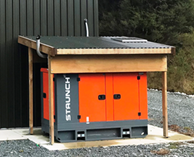
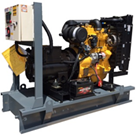
How best do I look after my genset?
Read the operator manual supplied and follow the instructions. Here are a few additional tips
- Run your genset regularly under load – at least once a month. If your inverter is setup to do this automatically, make sure the genset is actually starting and running as expected.
- Use the fuel in the tank. The diesel should be turned over a minimum of once a year – but more often in cold, damp conditions. Fuel goes off over time, which causes reliability issues.
- Keep it clean and dust free as already mentioned above.
- Change the oil and filters at the recommend operating hours or annually.
- Check hose clips annually.
- An ideal gauge of the genset’s health is exhaust smoke. All diesel engines will puff a little smoke when starting, however when running the smoke should be relatively clear, particularly when the set is up to operating temperature. White smoke suggests impurities in the fuel, normally water. Check the fuel filter for signs. Black smoke suggests it is overloaded or the engine is not getting enough air. Check the load and air cleaner. Contact your supplier if you are concerned. If your genset is smoking excessively something is wrong that needs to be resolved.
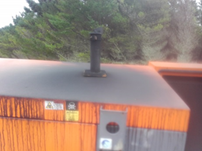
We hope this assists you when considering a generator for your off-grid solar system. Please never hesitate to contact the team here at Kilowatt Machinery for assistance in getting the best generator for every application.
